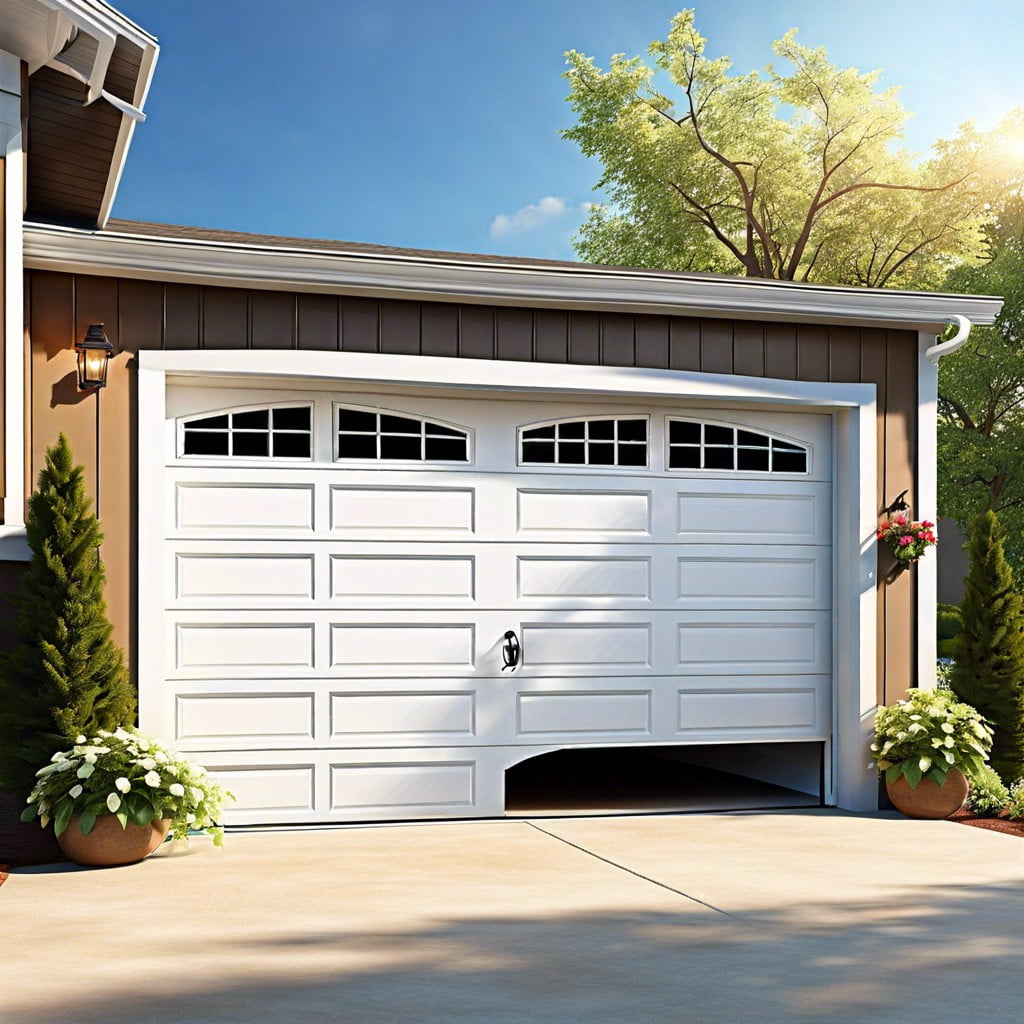Learn the step-by-step process to effectively fix your garage door, from identifying issues to executing the repair safely and efficiently.
Key takeaways:
- Garage door struggling to open or close – check tracks, springs, and opener
- Broken springs – seek professional assistance or follow safety procedures
- Roller issues – inspect for wear, replace if necessary, and lubricate regularly
- Dying opener – look for signs of malfunction and consider replacement
- Garage door off track – address promptly, realign tracks and rollers
Trouble Opening or Closing

If your garage door is struggling to open or close, it might be due to a misaligned track, an obstruction, or an issue with the door’s tension springs. Start by checking the tracks for dirt, debris, or dents, and clean or straighten as necessary. Inspect the springs for signs of wear or damage—if they’re broken or worn out, they’ll need to be replaced, which is best handled by a professional due to the high tension involved. Keep an eye on the opener as well; if it’s noisy or hesitant, the problem could be electrical or mechanical, requiring a closer look at the motor or the gears. Regular lubrication of the rollers, hinges, and tracks can prevent some issues, but if the door continues to malfunction, consider seeking professional assistance to ensure safety and proper functionality.
Broken Springs
Torsion springs and extension springs are integral to the garage door’s lifting mechanism. When a spring breaks, the door may become inoperable or severely compromised in function. It is crucial to recognize the signs of wear and damage on these springs—look for gaps in the torsion spring or overextended extension springs.
Attempting to replace springs can be dangerous due to the high tension they are under. It is strongly advised that homeowners opt for professional assistance when confronting spring-related issues. However, if you choose to perform the task, ensure to purchase the correct type of spring for your door, release tension carefully, and follow all safety procedures, including securing the door before beginning repairs. Regular maintenance, such as lubricating the springs, can prevent premature wear and prolong the life of these components.
Roller Issues
Rollers ensure smooth movement of a garage door along the tracks. With time, these can wear out or become misaligned. Nylon rollers are quieter and require less maintenance than steel, but are also less durable. When rollers are faulty, you may hear a scraping noise or observe a shaky motion when operating the door.
To address roller issues, first inspect for signs of wear such as cracks or flat spots. If rollers appear worn, replacing them is advisable. Lubricate the rollers regularly with a silicone-based lubricant to keep them moving smoothly, but avoid over-lubrication which can attract dirt that hampers movement.
If a roller has slipped out of the track, pause. Attempting to force the door can cause further damage. Carefully pry the edge of the track open with a pair of pliers, reinsert the roller, and gently tap the track back into place. Inspect the alignment of the track after this repair; misalignment could indicate a more serious issue, necessitating further adjustment or professional service. Always ensure the garage door is disconnected from the opener before performing any repairs to avoid injury.
Dying Opener
Garage door openers have a finite lifespan and can exhibit signs of malfunctioning as they near the end of their usefulness. Understanding the symptoms of a failing garage door opener can save you from unexpected breakdowns.
When the door responds sluggishly or makes unusual noises, the opener might be straining due to wear or need recalibration. Intermittent operation or unresponsiveness to remote commands often indicates electrical issues, such as faulty wiring or a depleted battery in the remote.
Inspect the opener for any visible damage or loose components. If the LED lights on the unit are blinking erratically or not at all, consult the owner’s manual to decipher the error code. Regular maintenance, including lubricating moving parts and checking the integrity of belts or chains, prolongs opener life.
If the opener is old or repairs become frequent, replacing it may be more cost-effective. Modern openers come with enhanced security features and the convenience of smart home connectivity, offering an opportunity to upgrade during replacement.
Garage Door Is Off Track
If your garage door has come off its track, it’s essential to address it promptly to prevent further damage. Here’s a guide to understand the issue and how to potentially fix it:
The track guides and supports the door as it opens and closes. A door that has come off its track may exhibit a noticeable gap between the rollers and the track, hindering smooth motion. This situation commonly arises due to an obstruction on the track, a significant impact to the door, or worn-out rollers.
Before trying to realign the door, ensure safety measures are in place. Disconnect the opener and secure the door to prevent it from moving unexpectedly. Inspect the tracks for any visible bends or breaks and straighten them using a pair of pliers if necessary.
Next, locate the rollers that have come off the track. Use a flathead screwdriver or a pair of pliers to carefully pry the outside edge of the track open. This will create enough space to re-seat the rollers. Once all the rollers are back on the track, close the opening in the track with light taps from a hammer.
It is crucial to realign the track for proper door movement. To do so, loosen the screws that hold the track to the door frame, adjust the track to the proper alignment, and retighten the screws. Finally, lubricate the rollers and tracks with a proper garage-door lubricant to allow smooth operation.
For significant issues or if the door seems too daunting to handle, seek professional assistance to ensure the repair is done safely and effectively. Regular maintenance can help prevent the door from coming off its track in the future.